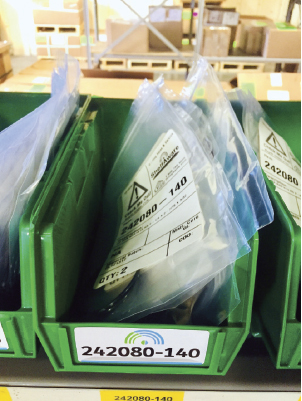As contractors continue to deal with many challenges (including rising labor costs, labor shortages, economic uncertainty, risk of recession, and the rising cost of materials) supply chain issues remain at the forefront of their concerns. Contractors are finding ways to be more lean and more efficient with regard to inventory management, and many of them are using sophisticated technology to automate operations and stay ahead of the curve.
The mechanical, electrical, and plumbing trades have been hit the hardest in 2023. However, the contractors who consider a digital vendor managed inventory (VMI) solution can begin to picture a world where real-time consumption data flows through a customizable, secure, cloud-based, easy-to-install and deploy platform that makes valuable information visible to both the suppliers and the consumers. It’s a solution that ensures a lean inventory pipeline with no stockouts.
The simple-to-use technology is affordable and robust. Accurate and granular consumption data automatically generates the required supply chain documents and digitizes sales order entry for the suppliers—eliminating purchase order entry and receipt entry for the consumer.
This type of inventory automation is a big win for the entire construction industry supply chain. If you want to know what is on your shelf, a digital VMI platform provides complete visibility and massive amounts of data to track.
But there are even more advantages—such as collaboration among suppliers through data-driven CloudSourcingTM, which allows independent suppliers to work together with a consumer on a single RFID-powered supply chain platform that manages complex supply chains.
SUPPLY CHAIN MANAGEMENT
Consider the complex supply chain of a huge construction project like the development of 4,000 apartment buildings with on-site trailers stocked full of inventory—including sheet metal, lumber, screws, nails, wood glue, safety products, bolts, hardware hinges, door hinges, electrical wiring components, piping, HVAC equipment, pumps, etc.
A robust, cloud-based, digital VMI platform uses powerful RFID technology and the Internet of Things to manage that inventory being consumed by multiple workers, managers, and various suppliers. A worker simply walks into the trailer and gathers the supplies needed. A split-second scan of the RFID smart labels on each product instantly records massive amounts of data, creates a purchase order to replace the supplies, and manages the least amount of inventory required of each product to keep the inventory as lean as possible with no possibility of stockouts.
A similar scenario applies to truck-bound inventory coming from off-site warehouses. For example, using automation a plumbing supply company can deploy several trucks of supplies to various jobsites, deliver the materials needed, and return to the warehouse with the necessary data to refill the trucks with supplies for the following day’s deliveries.
An effective digital VMI system alerts the plumbing supplier about exactly what is in each truck and also delivers accurate data about what has been consumed from each truck. A handheld scanner performs an instant inventory audit and automatically generates and delivers all the paperwork necessary to restock the necessary supplies.
The platform also works for remote warehouses that are accessed by multiple suppliers and consumers. As inventory is pulled from each warehouse at any time of the day or night, the consumption data are automatically recorded from the RFID smart labels. No humans are required to man the warehouses or physically count inventory. Bills are automatically generated from the supplier to the consumer. Purchase orders to replace the products are automatically generated, eliminating the possibility of stockouts.
The trailers, trucks, and warehouses look like retail outlets on the inside (similar to ACE Hardware or Home Depot aisles). The user simply “shops” for what they need, picks the required supplies, swipes the RFID labels, and goes back to work. At any time, the consumer or supplier can see exactly what is on the shelf, what has been ordered, and what is being consumed on a regular basis to help keep the inventory as lean as possible.
The platform works for huge items like lumber, roofing supplies, water heaters, motors, HVAC systems, and pumps as well as with smaller items like nuts, bolts, and screws. If an RFID label can be placed on the item, it can be scanned with the consumption data recorded.

AUTOMATION, RFID TECH
Not to be confused with barcodes, which must be individually scanned with limited ability to record complex data, RFID technology uses a magical user interface. It eliminates the need for screens, keyboards, and handheld or peripheral devices—all of which most contractors find inconvenient and obtrusive.
With RFID technology, the user can collect a bag of 500 small pieces along with 100 other various supplies in a bin. When placed on the scanning table, one RFID swipe instantly calculates the entire inventory of all the pieces in the bin while recording extremely accurate data.
The digital VMI hardware is connected to a cell tower, which is used to instantly report the consumption data back to the supplier so that inventories can be replenished automatically. The data is completely visible and transparent.
If a contractor is working with several different suppliers on a jobsite, a digital VMI allows all those suppliers to be on the same platform without disclosing proprietary information. Within the digital platform, the suppliers can only see their own data and not the data of the other collaborating suppliers.
However, the contractor can quickly see which components are available from which suppliers because the collective data is visible to them. The consumer collaborates with their partners, but the partners don’t have to collaborate with each other.
The platform provides them with the flexibility to filter the data to look at only one product or one category supplier. They could also filter the data to look at items that are close to stocking out, or they could filter the data to look at items that cost more than $500, for example. All the filters are designed to provide visibility and useful data across all the product category suppliers.
Before digital VMI technology existed, suppliers were forced to have multiple branch locations to physically deliver components to contractors, as needed. Now, even remote jobsites have the ability to get parts and supplies quickly, efficiently, and without the risk of stockouts that can halt production indefinitely.
When working an automated supply chain management system, contractors can remove daily clutter like multiple purchase orders and the physical counting of shelf inventory.
A digital VMI provides contractors with eyes on their inventory 24/7 with accurate, granular consumption data in real time. It allows them to work with several independent suppliers, which provides a better supply base than working with a single distributor of multiple products. A specific supplier list can be easily curated. Pushing the data to the consumer through the dashboard provides the contractor with their own dashboard to see exactly what’s on the shelf and what is running low.
CLOSING THOUGHT
With no end in sight to rising labor costs and continued economic uncertainty, it is clear that the construction industry can leverage practical technology such as digital VMI to fill those gaps and effectively manage complex supply chains.
About the Author:
TAndrew Johnson is an entrepreneur, inventor, and business owner. Formerly the sales manager at the family distribution company, he is now the CEO of ShelfAware, which is redefining industrial supply chains by leveraging RFID technology, the internet, and the power of data. He can be reached at andrew@shelfawarevmi.com or 913.270.8400. For more, visit shelfawarevmi.com.
Modern Contractor Solutions, September 2023
Did you enjoy this article?
Subscribe to the FREE Digital Edition of Modern Contractor Solutions magazine.



